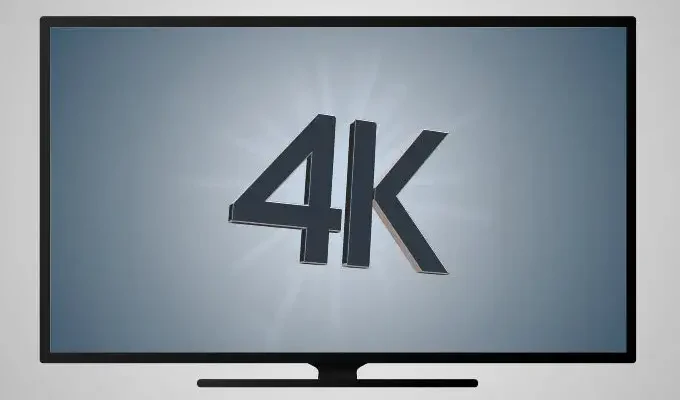We’re already well into the 4K era. HDTVs with a size of 1,920 by 1,080 pixels have been essentially replaced by larger, sharper 4K TVs featuring 4 times the number of pixels. 4K has progressed throughout its early stages, including some growing difficulties for initial users, and is now firmly established as the default kind of television available. 4K TVs are available in a variety of sizes and rates, notably 65-inch versions for around $1,000. This is an excellent opportunity to upgrade to 4K if you haven’t already. Here’s all you need to learn about it. We’ll be covering the very basic stuff.
?What exactly is 4K
4K TV is a significant improvement in TV resolution. 4K television, often known as “Ultra-HD,” has four times the amount of pixels as HDTV. As a consequence, the picture is clearer, sharper, and the colors are richer and stronger.
A display that has more than 8 million functional pixels is known as a 4K display. The quality for TVs has been set at 3,840 by 2,160 pixels. At 4,096 by 2,160 pixels, digital theater 4K (the quality in 4K cinemas) is somewhat better. It’s 4 times the amount of pixels on a 1080p monitor and almost a whopping 23 times the quality of regular definition tv, no matter how you measure it.
As a result, 4K is noticeably crisper than 1080p. A 4K TV of the very similar dimension can contain four pixels in the same area as a 1080p TV. If you have original 4K original content to view at that resolution, you’ll notice a considerable improvement in definition. Although if you wouldn’t, LG, Samsung, and Sony have created remarkable upconverting techniques that convert 1080p and lesser resolution material to 4K with different picture improvements. It’s not as excellent as native 4K material since you can’t just make more detail out of thin air, but it’s a decent stand-in.
Since the quality is much greater, more bandwidth is required to send it. The HDMI 2.0 protocol was created to enable 4K footage and provides for the projection of 2160p content at 60fps. This was a worry at first as HDMI 2.0 became more popular, but you can now expect almost any home entertainment platform you purchase to have HDMI 2.0, and according to our testing, you’d have to go trash hunting to discover an HDMI cord that couldn’t transfer a 4K60 HDR image. You may also view 4K video via the web, which needs a fast internet connection; Netflix suggests a constant 25Mbps downstream connection for streaming 4K material.
On smaller screens, it’s difficult to see the distinction among 1080p and 720p, but on 40-inch and bigger TVs, it’s clear. 4K is still another significant step forward in regards to both definition and clarity, particularly as consumers get used to the extremely small pixels shown by high-resolution displays on their phones. This is also a significant consideration for large TVs, particularly because 65-inch versions are now as cheap as 55-inch TVs were just a few years ago, and even 75-inch TVs are available at reasonable rates. While some models pushing past 80 inches, but at that point the the prices jump much higher.
Compare the resolutions of HD and 4K.
Display Resolution: 1,920 x 1,080 pixels
Display resolution: 3,840 x 2,160 pixels in 4K.
?Do I have that now
If you’re in the market for a new television and haven’t yet upgraded to 4K, now is the moment to do it. Our top TV choices are all 4K models with HDR compatibility. The technology has been regulated to the level where you can be fairly certain that a 4K tv you buy now will be prepared for the new, and it’s cheap enough to be priced similarly to 1080p TVs. Whatever your income, you’ll be able to locate a 4K TV that meets your requirements, most likely one that is HDR-compatible.
?What do I need to buy
For the last several years, 4K televisions have been on the market, and they have finally grown both cheap and useful. There is no longer a price premium for rapid adoption of 4K, and you can buy a wide variety of 4K TVs to suit your needs. A smart place to start is with a reference to the finest televisions. TCL and Hisense have created some outstanding TVs at affordable prices, while LG, Sony, and Vizio’s OLED TVs provide incredible contrast in ultra-slim designs.
Most big streaming media providers offer 4K HDR video material if you have a fast enough internet connection. 4K movies and programs are available on Amazon, Google Play, iTunes, Netflix, and Vudu. If that wasn’t enough, YouTube now allows anybody, from companies to GoPro owners, to upload 4K footage. Ultra high-definition material is also available on several of your favorite entertainment streamers.
?How much is this going to cost
New 4K TVs may cost anything from a few hundred to several thousand dollars. Costs for 4K televisions have fallen significantly in previous years, but now they’ve stabilized. Don’t wait too long to buy a 4K TV in the hopes of receiving a significant price reduction.
?Should I wait for 8k
No, is the simple response. The lengthy explanation is that 8K is currently available on certain high-end televisions, but it won’t be a significant issue for a while. In our 8K explanation, we go into more depth about what 8K represents and once you can anticipate it, but meanwhile, all you really need to understand is that certain TVs are capable of 8K quality (7,680 by 4,320, 4 times the quality of 4K), but no commercial content is currently in pure 8K and won’t be for a long period. However, there are no 8K broadcasting protocols or physical hardware that are recognized. You’ll be depending completely on the TV’s up-conversion procedure of 4K or lower resolution material if you invest the additional money on an 8K Television, and that would never be as smooth as an original 8K video.


